Green Tomato Pie
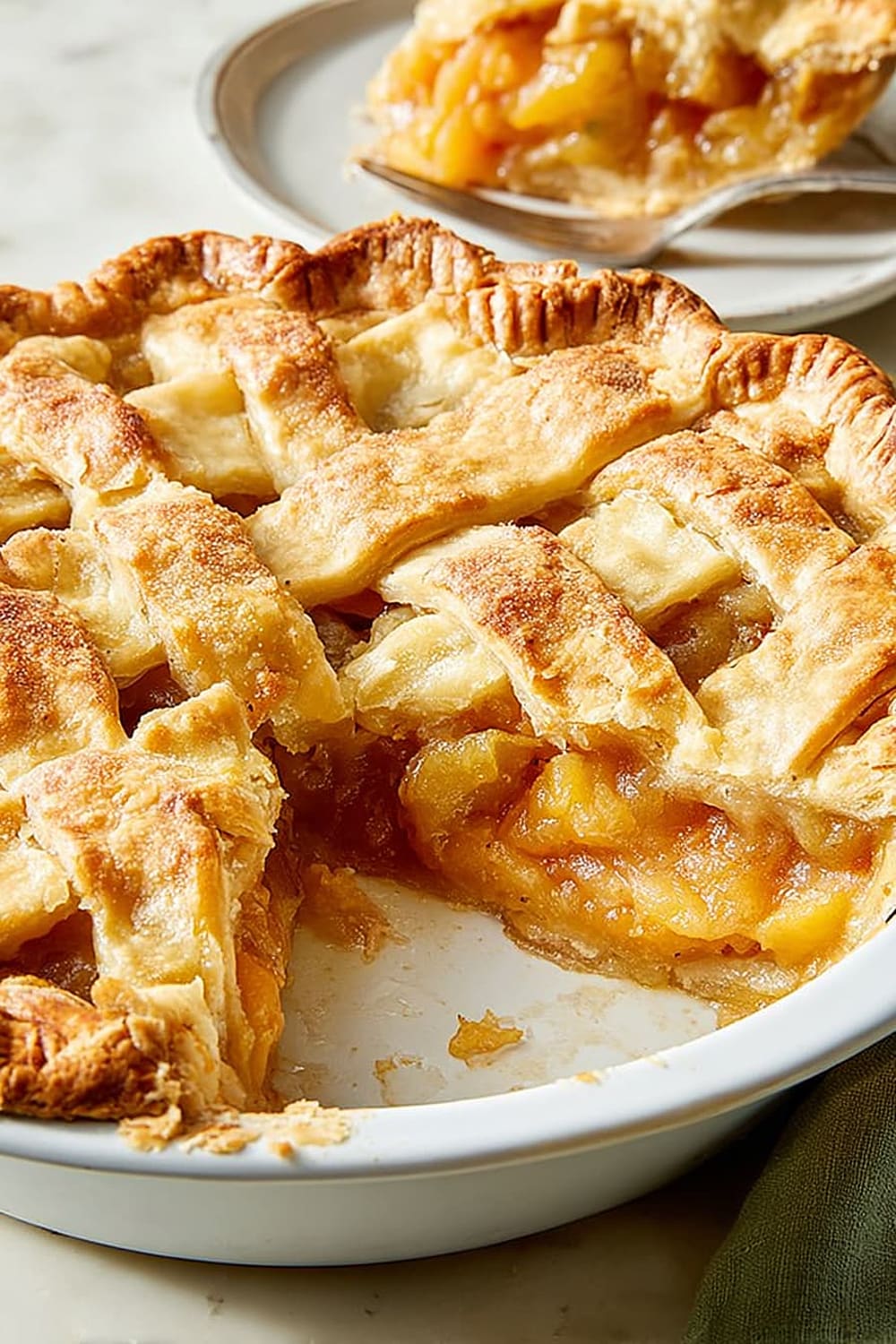
This pie is basically the perfect way to use up those stubborn green tomatoes that refuse to ripen before the first frost hits.
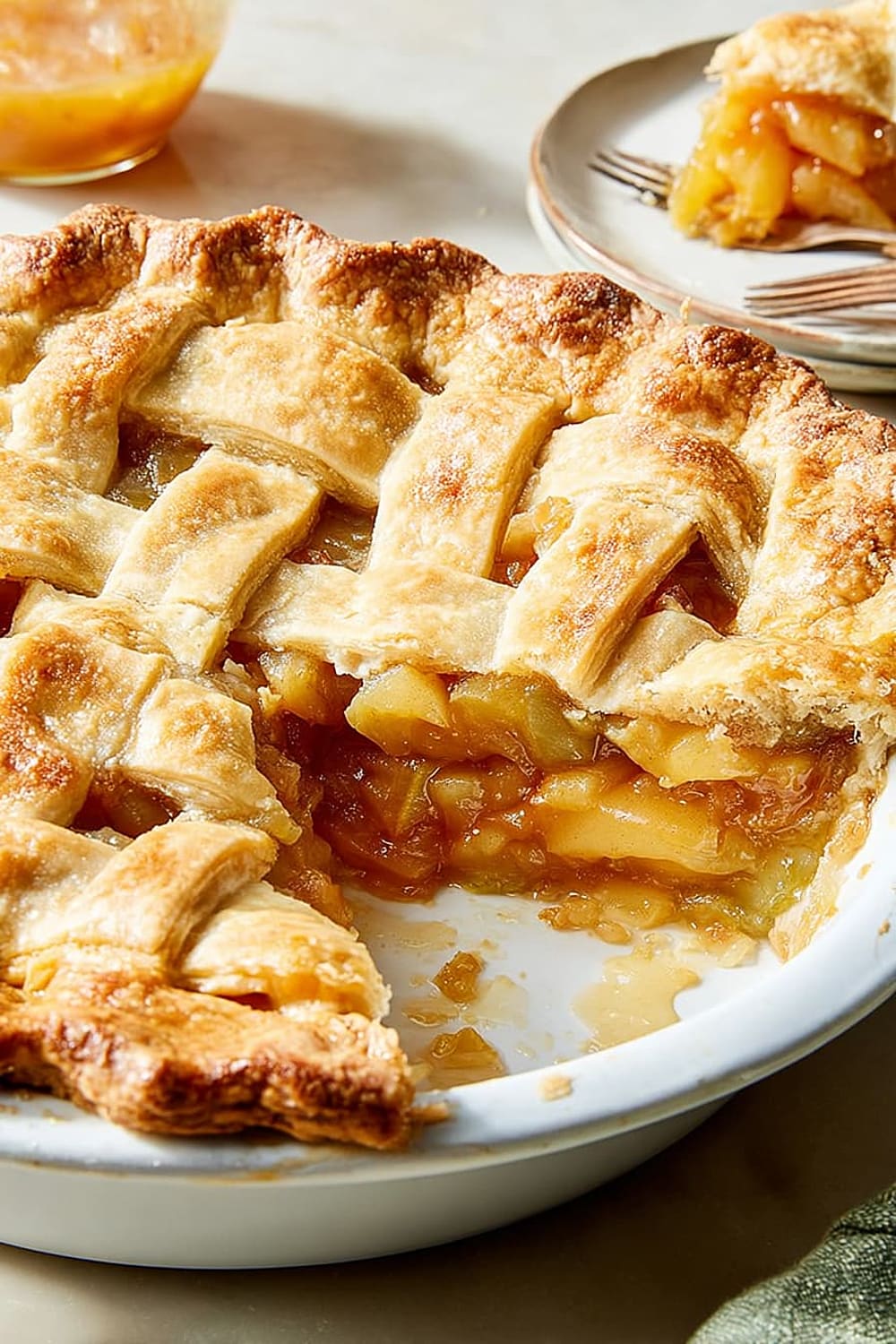
Warning: making this will result in neighbors suddenly becoming very friendly when they catch a whiff of that cinnamon-sugar magic wafting from your kitchen.

Green tomato pie is proof that sometimes the best desserts come from the most unexpected ingredients – tart, firm green tomatoes transform into something that tastes like apple pie’s mysterious and delicious cousin.
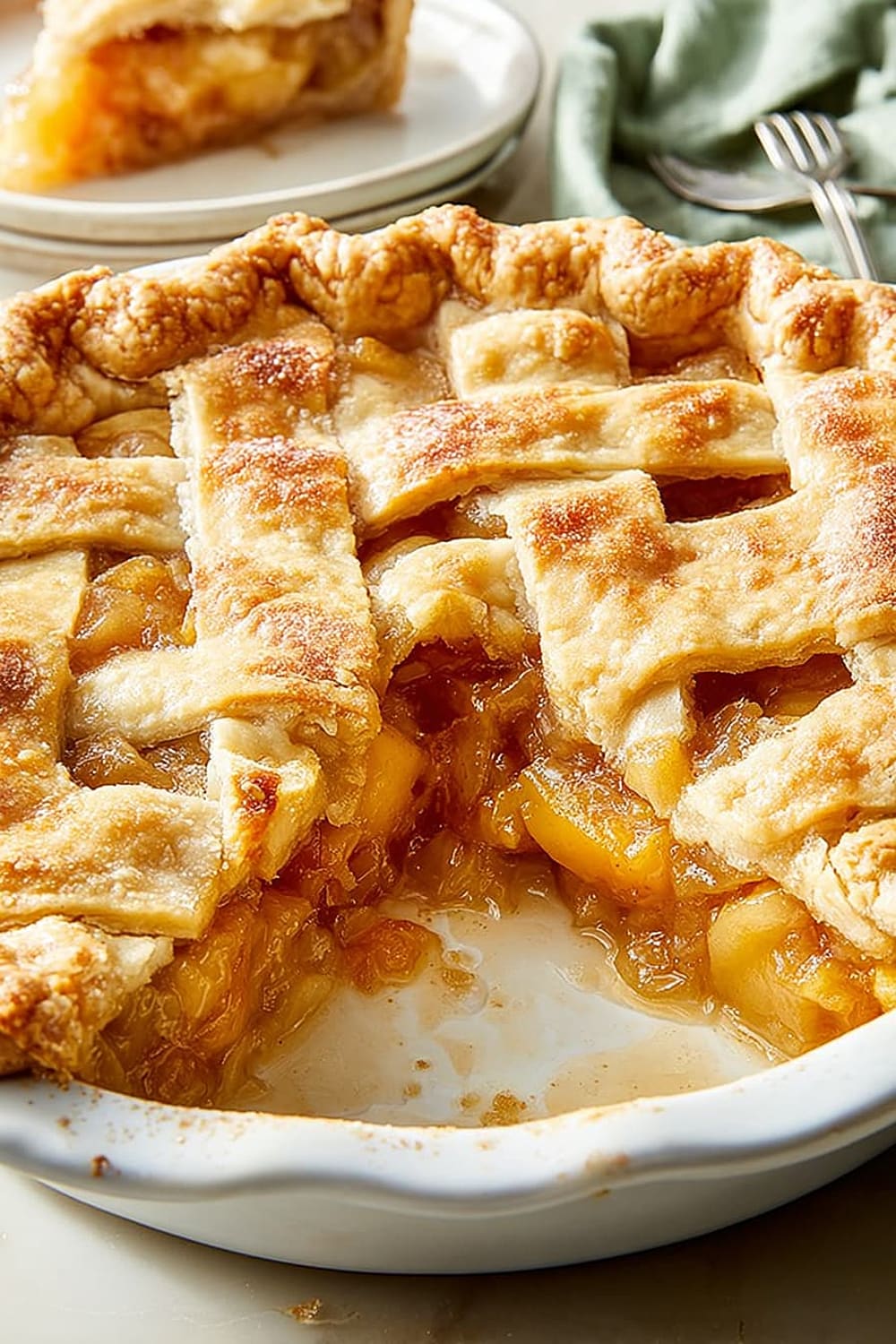
This recipe is the kind that makes you feel like a pioneer baker, turning garden “failures” into golden, flaky triumph that’ll have people asking for your secret.
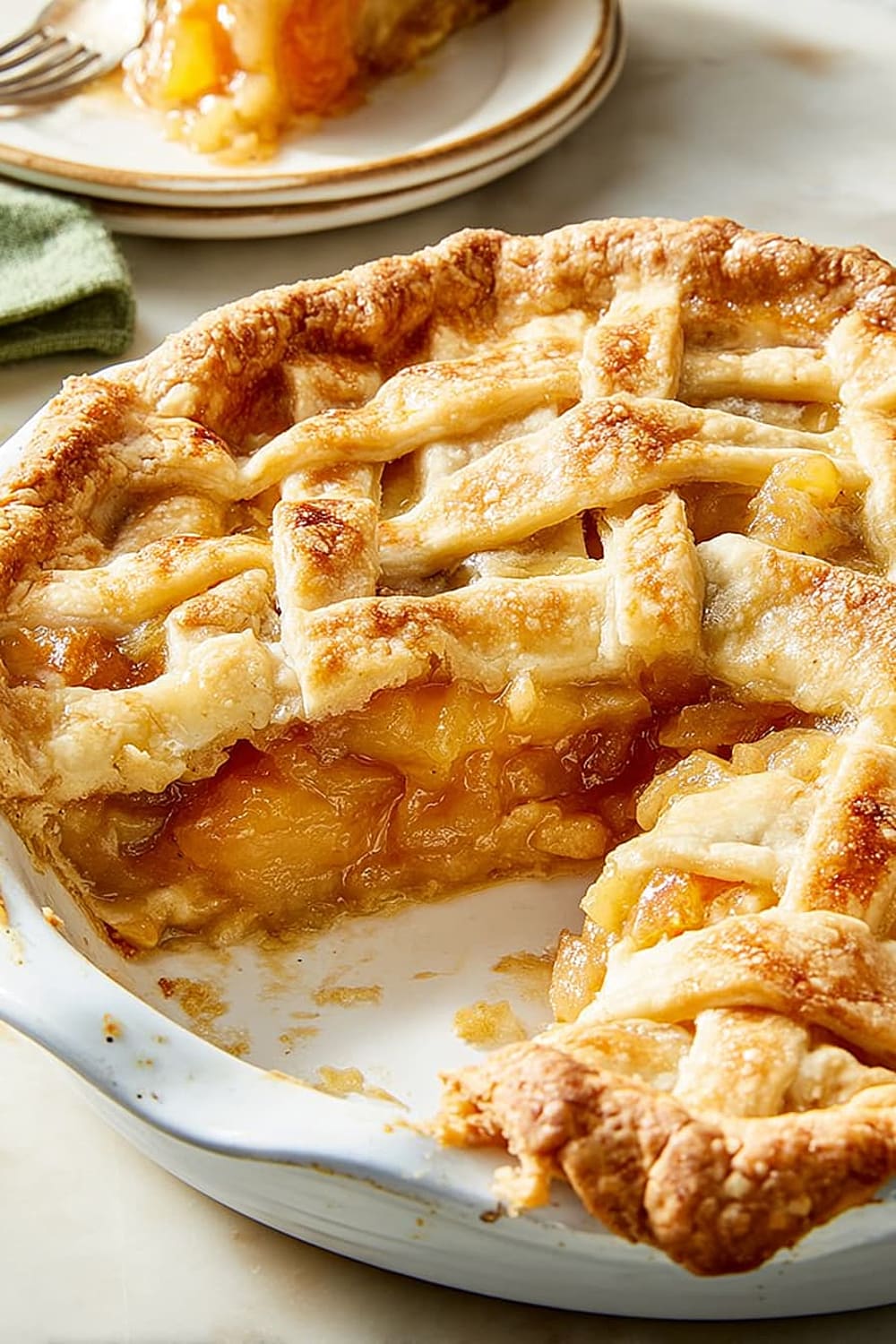
The beauty of this pie lies in how those acidic green tomatoes balance perfectly with warm cinnamon and sugar, creating a filling that’s both familiar and surprisingly unique.
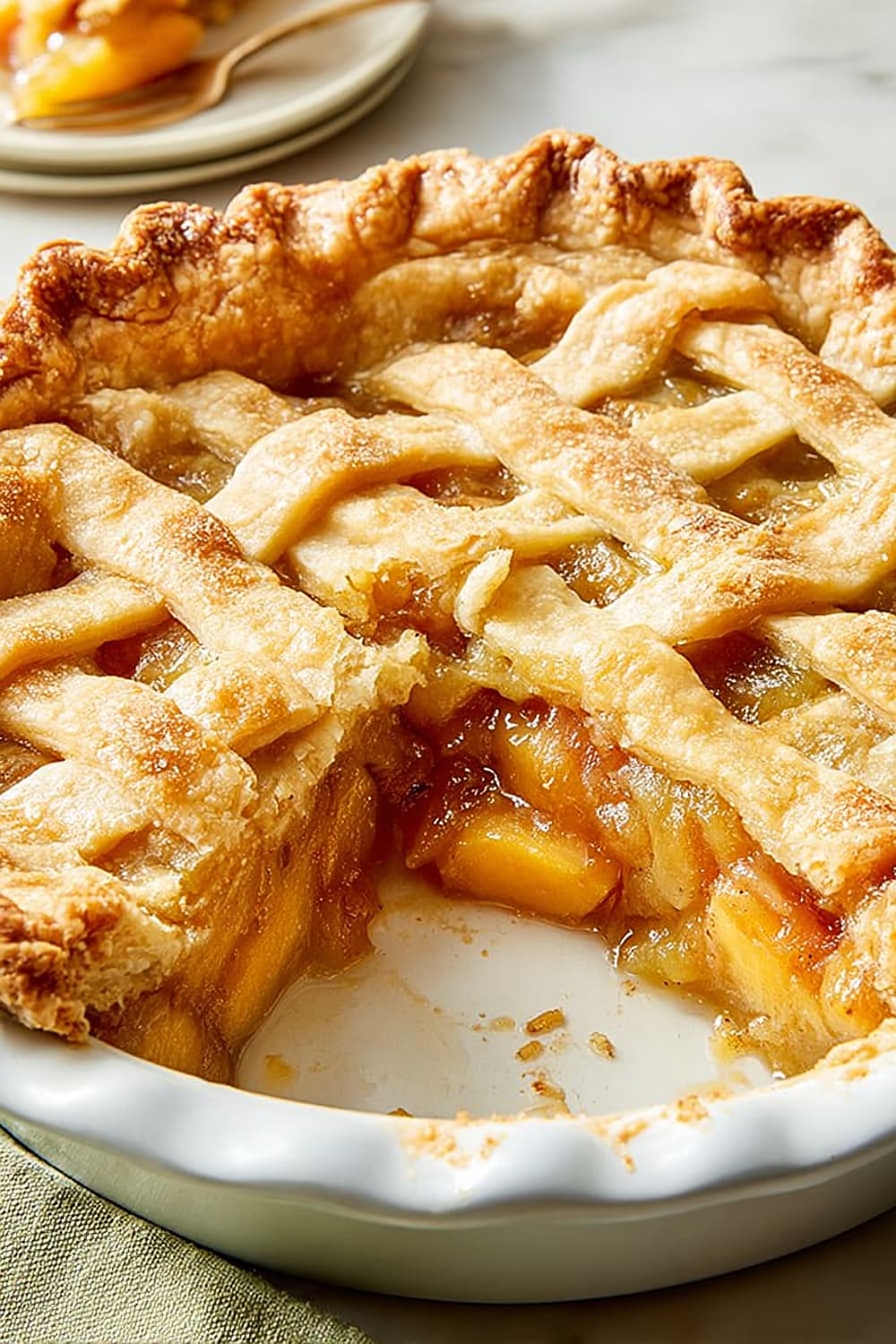
Prepare yourself for the ultimate compliment: “Wait, this is made with GREEN tomatoes?” Yes, and now you have the perfect excuse to make pie in late summer when your tomato plants are still loaded with unripe fruit.
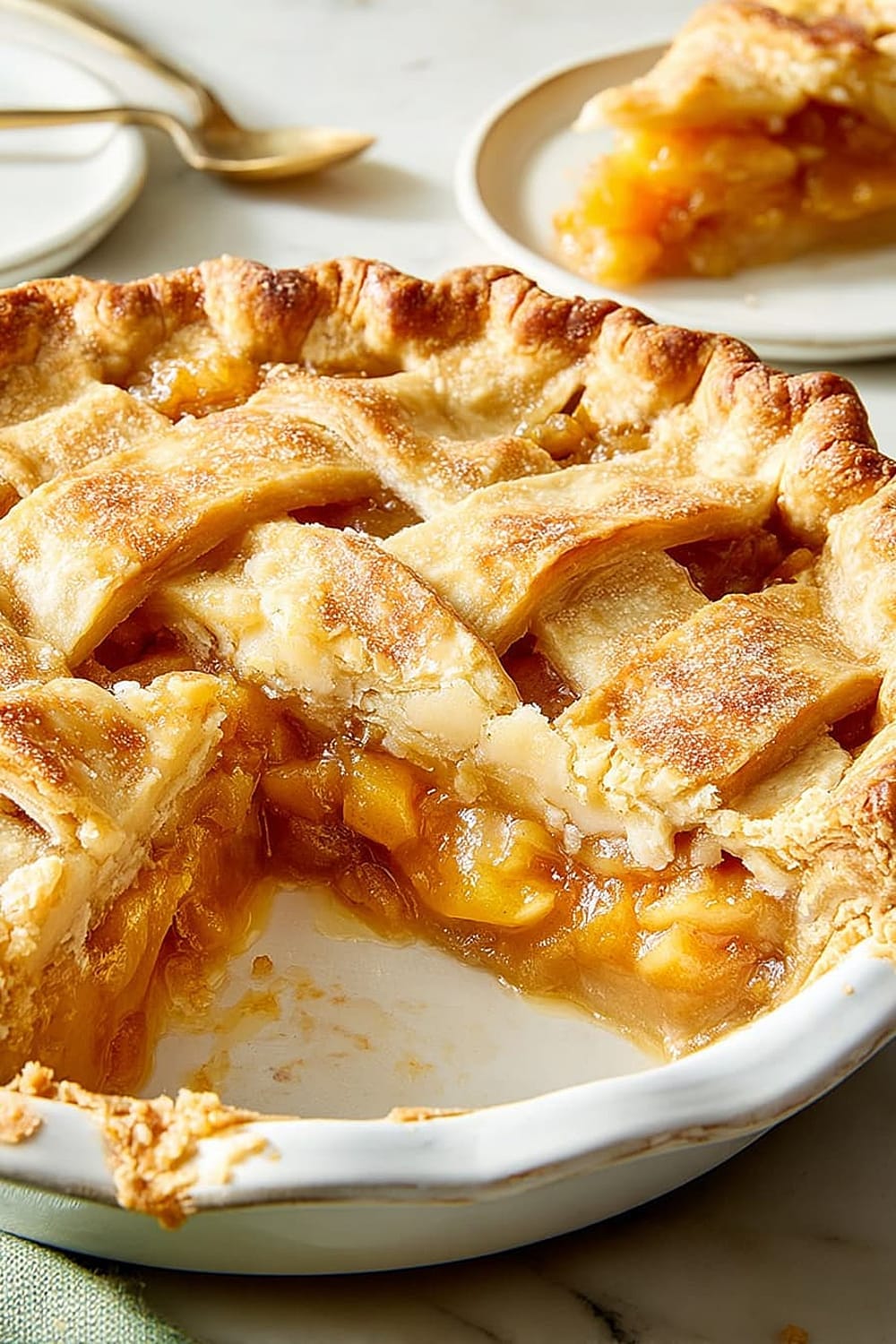
Ingredients
For the Filling
- 1-1 /2 cups sugar
- 5 tablespoons all-purpose flour
- 1 teaspoon ground cinnamon
- Pinch salt
- 3 cups thinly sliced green tomatoes (4 to 5 medium)
- 1 tablespoon cider vinegar
For Assembly
- Dough for double-crust pie (store-bought or homemade)
- 1 tablespoon butter
Instructions
Prepare the Filling
- 1 Preheat your oven to 350°F (175°C) and position a rack in the lower third of the oven for even bottom crust browning.
- 2 In a large mixing bowl, whisk together the 1-1/2 cups sugar, 5 tablespoons flour, 1 teaspoon cinnamon, and pinch of salt until evenly combined. The flour acts as a thickening agent to prevent a soggy bottom crust.
- 3 Add the 3 cups thinly sliced green tomatoes and 1 tablespoon cider vinegar to the sugar mixture. Toss gently but thoroughly to coat every tomato slice – this coating process is crucial for proper thickening and flavor distribution.
Assemble the Pie
- 4 On a lightly floured surface using a kitchen scale for precision if available, roll half the pie dough to a 1/8-inch-thick circle, rotating the dough frequently to maintain an even round shape. The circle should be about 2 inches larger than your pie plate.
- 5 Carefully transfer the rolled dough to a 9-inch pie plate, either by rolling it around your rolling pin or folding it in quarters. Gently press the dough into the bottom and sides without stretching, then trim to 1/2 inch beyond the rim of the plate.
- 6 Pour the tomato filling into the prepared crust, spreading it evenly with a silicone spatula. Dot the surface with small pieces of the 1 tablespoon butter – this adds richness and helps with browning.
Create the Lattice Top
- 7 Roll the remaining dough to another 1/8-inch-thick circle and cut into 1-inch-wide strips using a sharp knife or pastry wheel. You’ll need about 10-12 strips for a proper lattice pattern.
- 8 Arrange the strips over the filling in a classic lattice pattern: lay half the strips parallel across the pie, then weave the remaining strips perpendicular, alternating over and under. Trim the strips and seal them to the edge of the bottom crust by pressing gently with a fork.
- 9 Flute the edge decoratively by pinching the dough between your thumb and forefinger, creating a sealed border that prevents filling from bubbling over.
Bake and Cool
- 10 Bake for 60 minutes or until the tomatoes are fork-tender and the crust is golden brown. If the edges brown too quickly, cover them with aluminum foil strips during the last 15-20 minutes.
- 11 Cool completely on a wire rack to room temperature before slicing – this allows the filling to set properly. Store covered in the refrigerator for up to 3 days.
Recommended Equipment and Kitchen Tools
Recommended Tools (for best results)
- Rolling pin – A heavy wooden or marble rolling pin gives you better control when rolling pie dough to an even thickness, though a basic pin works fine too
- 9-inch pie plate – Glass or ceramic pie plates allow you to see the bottom crust browning, while metal pans conduct heat more efficiently for crispier crusts
- Pastry brush – Perfect for applying egg wash if you want a glossy top crust, though this recipe works beautifully without it
- Wire cooling rack – Essential for proper air circulation during cooling to prevent soggy bottom crusts
Helpful Upgrades
- Kitchen scale – Measuring ingredients by weight ensures consistent results, especially important for the flour-to-sugar ratio in the filling
- Bench scraper – Makes transferring rolled dough much easier and helps keep your work surface clean during the rolling process
- Silicone spatula – Ideal for gently folding the tomatoes with the sugar mixture without breaking the delicate slices
Nice-to-Have Options
- Pastry wheel – Creates perfectly straight, decorative edges on your lattice strips, though a sharp knife works just as well
- Pie weights – If you want to partially pre-bake your bottom crust for extra crispiness, though this recipe doesn’t require blind baking
Recipe Variations and Dietary Modifications
Gluten-Free Adaptation
- Replace the 5 tablespoons all-purpose flour with 4 tablespoons cornstarch or 3 tablespoons tapioca starch for thickening
- Use your favorite gluten-free pie crust recipe or store-bought alternative – the filling adapts perfectly to any crust type
- Add 1 extra tablespoon of thickening agent since gluten-free options sometimes need more binding power
- Baking time remains the same, but check that your gluten-free crust doesn’t over-brown
Dairy-Free Modifications
- Replace the 1 tablespoon butter with 1 tablespoon coconut oil (solid, not melted) or vegan butter substitute
- Ensure your pie crust is made with vegetable shortening or vegan butter instead of traditional butter
- The flavor remains virtually identical with these simple swaps
Reduced Sugar Version
- Cut sugar to 1 cup and add 1/2 teaspoon vanilla extract to enhance sweetness perception
- Try replacing 1/2 cup sugar with 1/3 cup maple syrup, but add 1 extra tablespoon flour to compensate for additional liquid
- Stevia or monk fruit sweeteners work, but use conversion charts as they’re much more concentrated than sugar
Flavor Variations
- Apple-Spice Style: Add 1/4 teaspoon nutmeg and 1/4 teaspoon allspice along with the cinnamon
- Citrus Twist: Replace cider vinegar with 1 tablespoon lemon juice and add 1 teaspoon lemon zest
- Ginger Warmth: Include 1/2 teaspoon ground ginger for a subtle spicy note that complements the tomatoes beautifully
Nutritional Information and Health Benefits
Key Nutritional Highlights
Each serving of this green tomato pie contains approximately 285 calories, with the majority coming from the natural fruit sugars and pie crust. The filling provides about 45 grams of carbohydrates per slice, including 3 grams of dietary fiber from the green tomatoes. While this is definitely a dessert, it’s lighter than many traditional fruit pies due to the naturally lower sugar content of green tomatoes compared to ripe fruit.
Health Benefits of Main Ingredients
Green tomatoes are nutritional powerhouses often overlooked in favor of their red counterparts. They’re rich in vitamin C and contain solanine, a natural compound with potential anti-inflammatory properties. The cider vinegar adds more than just flavor – it may help with blood sugar regulation and provides beneficial acetic acid. Cinnamon is loaded with antioxidants and has been studied for its potential blood sugar stabilizing effects, making it more than just a delicious spice addition.
Dietary Considerations
This recipe is naturally dairy-light (just 1 tablespoon butter) and egg-free in the filling, though the crust may contain eggs depending on your recipe choice. It’s suitable for vegetarians and can easily be made vegan with simple substitutions. The gluten content comes primarily from the flour in both filling and crust, but both can be modified for gluten-free diets. Consider serving smaller portions – 1/8 of the pie is satisfying due to the rich, sweet-tart flavor profile.
Smart Swaps and Ingredient Substitutions
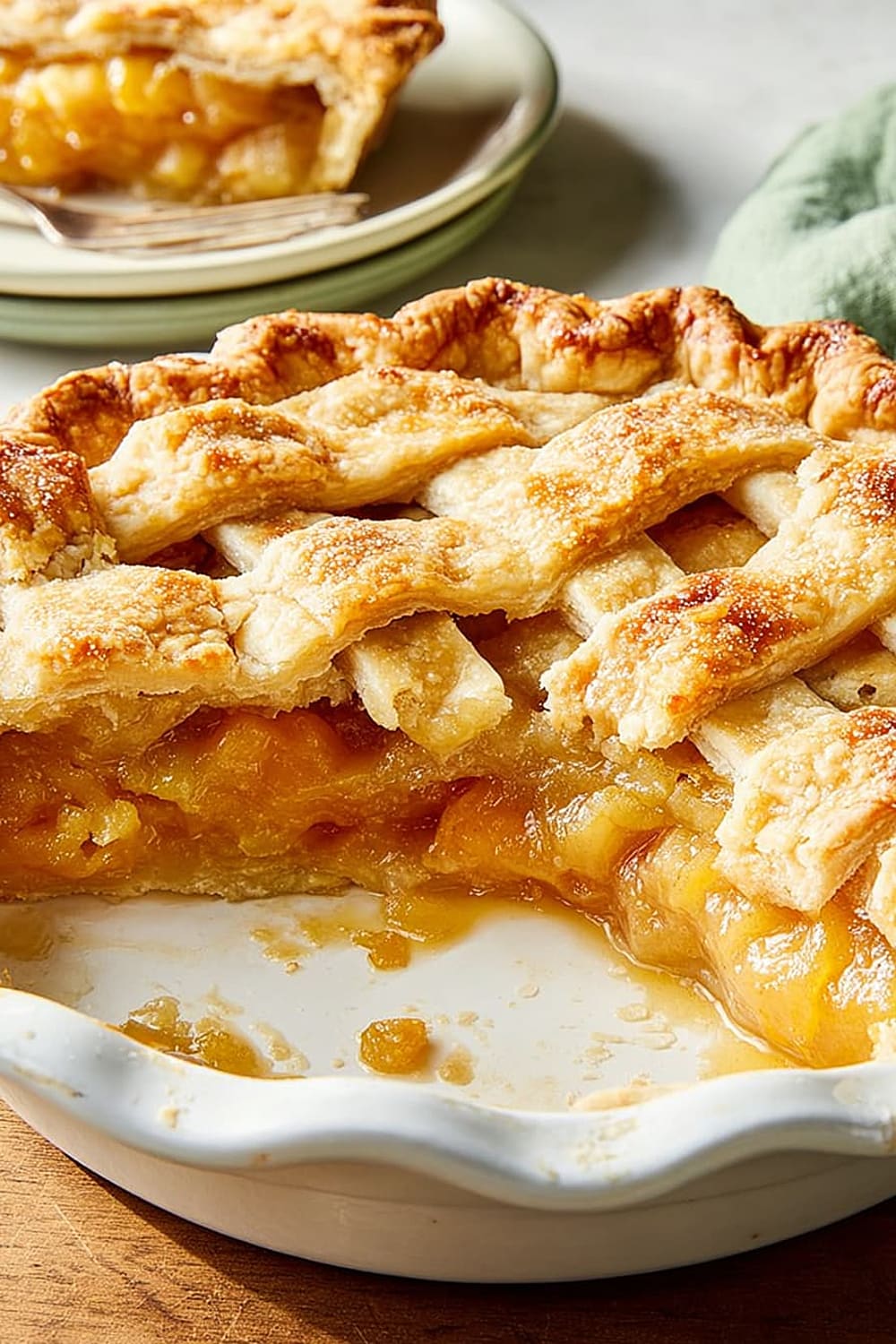
Common Substitutions:
- All-purpose flour → Cornstarch (use 3 tablespoons) or instant tapioca (use 4 tablespoons, ground fine)
- Ground cinnamon → Apple pie spice (use 3/4 teaspoon) or pumpkin pie spice (use 1/2 teaspoon)
- Cider vinegar → White wine vinegar or lemon juice (same amount) for similar acidity
- Granulated sugar → Brown sugar (use 1-1/4 cups packed) for deeper, molasses-like flavor
Budget-Friendly Swaps:
- Store-bought pie crust → Homemade basic pastry using flour, shortening, salt, and water saves significantly
- Organic cider vinegar → Regular white vinegar works perfectly for the acidic component needed
- Premium cinnamon → Standard ground cinnamon from the baking aisle performs identically in this recipe
Pantry Emergency Substitutions:
- Fresh green tomatoes → Canned green tomatoes (drain thoroughly and pat dry before using)
- Ground cinnamon → Cinnamon stick (grate 1 stick on a microplane grater for fresh flavor)
- Butter → Coconut oil (solid), vegetable shortening, or even cream cheese for richness
Pro Tips for Substitutions:
- When using liquid sweeteners like maple syrup, increase flour by 1 tablespoon to maintain proper consistency
- Store leftover cider vinegar in a cool, dark place – it keeps for years and enhances many baking recipes
Make It Diabetes-Friendly
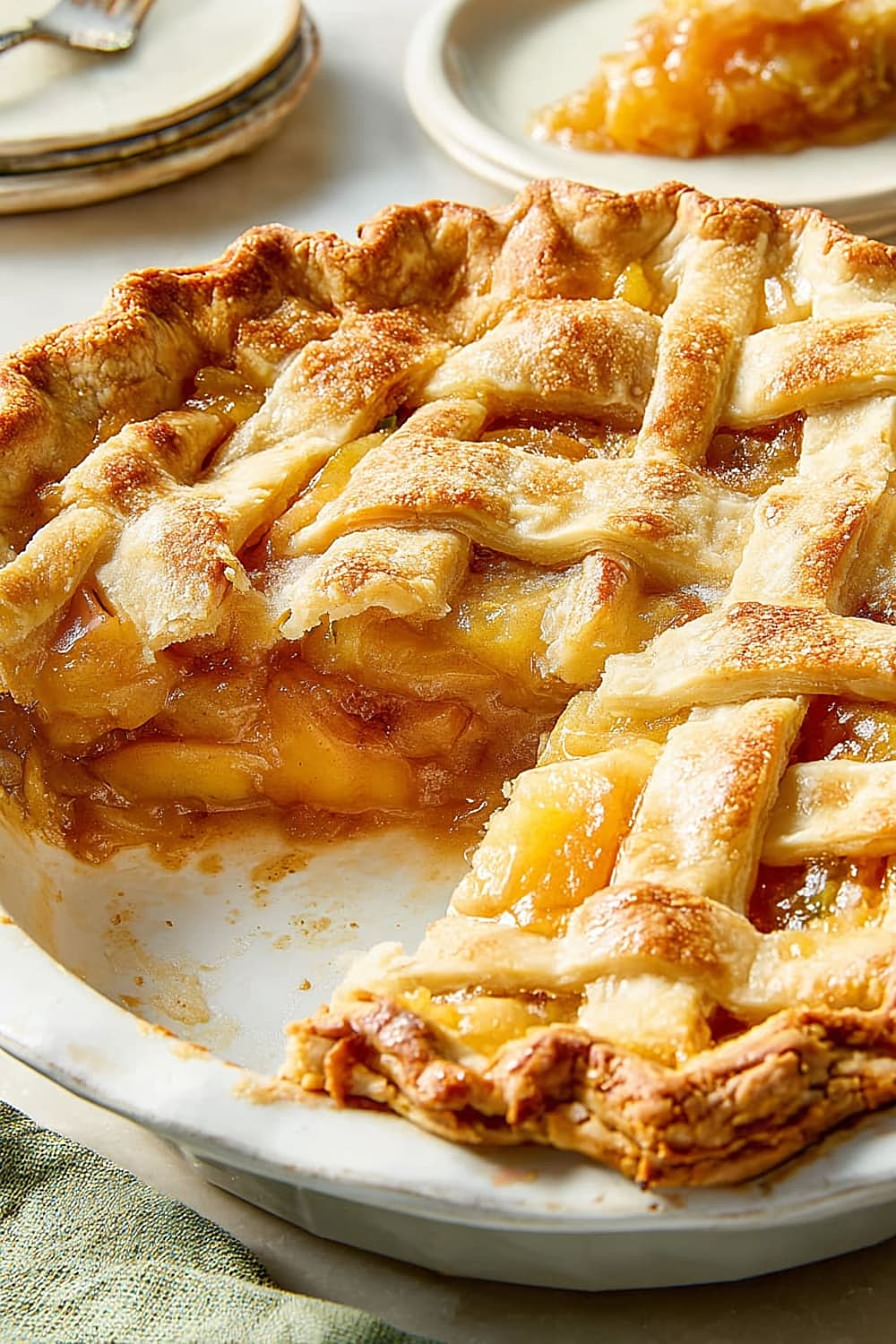
Sugar Substitutions:
- Replace the 1-1/2 cups sugar with 3/4 cup erythritol or 1/2 cup stevia blend designed for baking
- Monk fruit sweetener works excellently – use 1/2 cup to replace the full sugar amount
- Add 1 teaspoon vanilla extract when using alternative sweeteners to enhance perceived sweetness
- Total carb reduction: Approximately 35-40 grams fewer carbs per slice with these substitutions
Flour & Carb Modifications:
- Replace 5 tablespoons all-purpose flour with 3 tablespoons almond flour plus 2 tablespoons cornstarch
- Consider a low-carb pie crust made with almond flour and coconut flour to reduce total carbs by another 15-20 grams per slice
- Portion control: Cut into 10 slices instead of 8 for better carb management per serving
Portion & Timing Tips:
- Serve smaller portions (1/10 of pie) with Greek yogurt or sugar-free whipped cream for added protein
- Estimated carbs per modified slice: 18-22 grams instead of original 45 grams
- Pair with nuts or cheese to help slow glucose absorption and increase satiety
Blood Sugar Considerations:
- The cider vinegar naturally helps moderate blood sugar spikes
- Cinnamon may provide additional blood sugar benefits when consumed regularly
Perfect Pairing Suggestions
Beverage Pairings
This unique pie pairs beautifully with medium-bodied red wines like Merlot or Pinot Noir, which complement the tart-sweet flavor without overwhelming the delicate tomato notes. For white wine lovers, a slightly sweet Riesling or Moscato creates a lovely contrast. Coffee enthusiasts will find that a medium roast coffee enhances the cinnamon notes, while black tea with honey provides a comforting, traditional pairing. Sparkling apple cider makes an excellent non-alcoholic choice that echoes the pie’s orchard-like qualities.
Side Dish Recommendations
Serve alongside vanilla bean ice cream or fresh whipped cream to balance the pie’s tartness with cool, creamy richness. Sharp cheddar cheese might sound unusual, but it’s a traditional pairing that highlights both the cheese’s complexity and the pie’s unique flavor profile. For a lighter option, Greek yogurt with honey provides protein and probiotics while complementing the dessert’s tangy elements. Toasted pecans or walnuts add textural contrast and healthy fats.
Complete Meal Ideas
This pie makes an excellent ending to harvest-themed dinners featuring roast chicken, pork tenderloin, or hearty vegetarian stews. It’s particularly stunning after Southern-style meals with fried chicken, cornbread, and collard greens. For casual entertaining, serve it at potluck dinners, church socials, or family reunions where its conversation-starting uniqueness will be appreciated. Holiday meals benefit from this pie’s seasonal appeal – it’s perfect for Thanksgiving when you want something different from traditional pumpkin pie.
Pro Tips and Troubleshooting
Professional Techniques
Salt your sliced green tomatoes lightly and let them drain for 30 minutes before mixing with sugar – this removes excess moisture and concentrates flavors. Use an instant-read thermometer to check doneness; the center should reach 185°F (85°C) when fully set. For extra flavor depth, let your sugar-tomato mixture sit for 15 minutes before filling the crust, allowing natural juices to develop.
Common Mistakes and Solutions
Soggy bottom crust is the biggest challenge – prevent it by placing your pie on the lowest oven rack and using a preheated baking stone if you have one. If your lattice strips shrink during baking, you rolled the dough too thin or stretched it while arranging. Runny filling usually means insufficient thickening agent or underbaking – make sure tomatoes are completely tender before removing from oven.
Storage and Make-Ahead Strategies
This pie actually improves overnight as flavors meld and filling sets completely. Store covered in the refrigerator for up to 4 days. You can assemble the entire pie morning-of and refrigerate until baking time. Freezing works well – wrap tightly and freeze for up to 3 months, then thaw overnight before serving. For best texture, avoid reheating individual slices in the microwave; instead, warm briefly in a 300°F (150°C) oven.
Scaling and Presentation
This recipe doubles perfectly for crowd feeding – use two standard pie plates rather than one large pan for even baking. For elegant presentation, dust with powdered sugar just before serving, or drizzle with a simple vanilla glaze. Individual tartlets make charming single servings using muffin tins and smaller pastry circles.